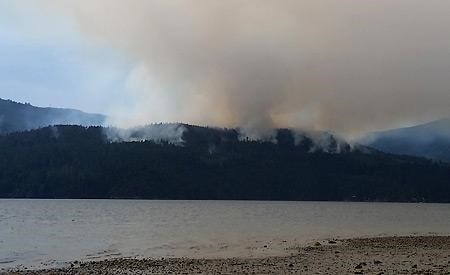As wildfires spread around the province over the weekend, Powell River woke up Sunday morning, July 5, to smokey skies and a layer of ash coating cars.
Ryan Thoms, manager of emergency services for the Powell River Regional Emergency Program, said the smokey conditions were from two large fires near Pemberton which grew substantially over the weekend. They include a 20,000-hectare fire in the Elaho Valley and a 5,000-hectare fire near Boulder Creek. That is in addition to a 250-hectare Carlson Point fire near Halfmoon Bay on the west side of Sechelt Inlet on the Lower Sunshine Coast, one near Port Hardy and one near Nanaimo on Vancouver Island.
Meteorologists add that smoke from the interior and north of the province is also being drawn to the coast and could be adding to the smokey conditions.
The ministry of environment and Vancouver Coastal Health issued a wildfire smoke advisory for the Sunshine Coast and surrounding areas.
“This situation is expected to persist until meteorological conditions change,” stated the advisory.
The advisory recommends the public avoid strenuous outdoor activities and contact health care providers if they experience difficulty breathing, chest pain or discomfort and sudden onset of cough or irritation of airways.
Exposure to smoke is of particular concern for infants, the elderly or anyone who has underlying medical conditions such as diabetes and lung or heart disease, the advisory stated.
For more information about air quality in Powell River, readers can visit the province's Air Quality website.
As the mercury soared late last month, Powell River was one of many communities on the coast and in the interior of the province where heat records fell.
Temperatures in Powell River, measured at the airport, hit a high of 27.6° Celsius on Friday, June 26, surpassing a 2006 record of 27.5°C. Weather observer John Ede recorded 30.1°C at the airport on Saturday, June 27, also 0.1 degree warmer than the previous record-setting temperatures. Sunday, June 28, was the hottest day of the month at 30.7°C breaking the 1995 record for that day set at 29.8°C.
Despite the extreme temperatures at the end of the month, average temperatures for the whole month were up, almost three degrees higher compared to the month’s climate normals, Ede said. Maximum mean temperature, an average of each day’s high, was 23.9°C, four and a half degrees warmer.
At Powell River airport, only 17 millimetres of rain were tallied during the month, about a quarter of what current climate normals, based on the last 30 years of data, say is normal. More than 100 hours extra sunshine was recorded at 343.8 hours.
Low rainfall in the past few months coupled with Environment Canada’s seasonal climate predication of sustained heat is causing increased concern over drought.
On Friday, July 3, the provincial government declared level four drought restrictions for Vancouver Island and the Gulf Islands and took the extra step to suspend fishing in the areas’ angling streams and rivers to protect vulnerable fish stocks.
Haslam Lake, the reservoir which the City of Powell River taps for its drinking water, has a height range of between 563.9 feet (171.9 metres) and 568.9 feet (173.4 metres) with the highest water levels recorded in the late spring and the lowest at the end of July and into August, according to Jeremy Sagebiel, engineering technologist with the city.
Monitored on a weekly basis, its current level is 565.6 feet (172.396 metres), he said.
“A drought is not on the forefront for Powell River, but it is definitely a possibility if we have a few more years of this,” said Sagebiel. “We are obviously going to need to be more aggressive with water restrictions.” He said city staff will recommend a revised water restriction policy to council in the near future, a progressive policy which would allow for finer tuned restrictions depending on circumstances.
At the beginning of June the city announced water restrictions. Properties with odd-numbered street addresses may water on odd calendar days only, while properties with even-numbered street addresses may water on even calendar days. Only one hose may be used for watering purposes at a time.



